
About UsThe Numismatic Bibliomania Society is a non-profit organization promoting numismatic literature. For more information please see our web site at coinbooks.org SubscriptionsThose wishing to become new E-Sylum subscribers (or wishing to Unsubscribe) can go to the following web page link MembershipThere is a membership application available on the web site Membership Application To join, print the application and return it with your check to the address printed on the application. Membership is only $15 to addresses in the U.S., $20 for First Class mail, and $25 elsewhere. For those without web access, write to: David M. Sundman, Treasurer AsylumFor Asylum mailing address changes and other membership questions, contact David at this email address: dsundman@LittletonCoin.com SubmissionsTo submit items for publication in The E-Sylum, just Reply to this message, or write to the Editor at this address: whomren@gmail.com
BUY THE BOOK BEFORE THE COIN |
- WAYNE'S WORDS: THE E-SYLUM JANUARY 12, 2014
- JOHN H. BURNS 1958-2014
- SKLOW SALE #21 CLOSES FEBRUARY 15, 2014
- NEW BOOK: DANISH-NORWEGIAN-SWEDISH NUMISMATIC BIBLIOGRAPHY
- NEW BOOK: MONETA PUBLICATION 167: HONG KONG MINT
- NEW BOOK: ROMANIA TOKENS, TAGS AND CHIPS
- BONHAM'S TO SELL AUGUSTIN DUPRÉ ARCHIVE
- AN AUGUSTIN DUPRÉ GALLERY
- WILLIAM S. APPLETON'S REMARKS ON AUGUSTIN DUPRÉ
- YVES BARIL AND THE "DEVIL'S HEAD" PORTRAIT
- NOTES FROM E-SYLUM READERS: JANUARY 12, 2014
- PRESIDENCY RELINQUISHED MEDAL RESTRIKE REVISITED
- BRASHER DOUBLOON REALIZES $4,582,500 AT HERITAGE AUCTION
- GREENBACK BACKER ELDRIDGE G. SPAULDING'S BANKNOTE
- COLLECTING CITY OF NEW ORLEANS SCRIP
- MORE ON THE DEERFIELD, MONTANA HORSE CAR TOKEN
- MORE ON COUNTERFEITS, REPLICAS AND FANTASIES
- PETITION QUESTIONS FIRST WORLD WAR CENTENNIAL COIN
- QUERY: YEATMAN & ARMISTEAD TOKEN INFORMATION SOUGHT
- EARLIER COIN DEALER PHONE NUMBERS FOUND
- PUNCTUATION PUGILISM PERSISTS
- ABOUT THE AUTHOR: STARR GILMORE
- DICK JOHNSON: ANA HALL OF FAME FALLS FLAT
- JOHN MERCANTI DESIGNS AUSTRALIAN EAGLE COIN REVERSE
- WORTHLESS ZIMBABWE NOTES RISE IN PRICE
- PROS AND CONS OF POLYMER BANKNOTES
- GREENING THE WORLD BY CLEANING THE WORLD'S BANKNOTES
- COIN HOARDS AND GOOGLE MAPS SHOW ANTIOCH'S INFLUENCE
- COIN CARD POSTCARD ALBUM CENSUS
- HOW ROMAN COWS BECAME COINS
- PHOTOFUNIA: CREATE A COIN FROM ANY PHOTO
- FEATURED WEB PAGE: PHRYGIAN CAP
Click here to access the complete archive
To comment or submit articles, reply to whomren@gmail.com
WAYNE'S WORDS: THE E-SYLUM JANUARY 12, 2014

New subscribers this week include Skyler Liechty and Michael S. Turrini, courtesy of Tony Lopez; and 'Doctor' Lloyd G. Chan and Michael M. 'Steamer' Stanley, courtesy of Michael S. Turrini. Welcome aboard! We have 1,682 email subscribers.
This week we open with sad news of the loss of a fixture on the U.S. coin show circuit, numismatic literature dealer John Burns, who passed away Friday night during the FUN show in Florida. He will be greatly missed.
Other topics include the upcoming Sklow literature sale, three new numismatic books, New Orleans scrip, author Starr Gilmore, the ANA Hall of Fame, and banknote cleaning. But the news for numismatic researchers this week came from Bonhams, which announced the upcoming auction of an archive of historical documents, coins and medals created and owned by Augustin Dupré (1748-1833).
To learn more about the rise and fall of the Hong Kong Mint, the Diplomatic Medal, the 1787 Brasher Doubloon, engraver Yves Baril, Congressman Eldridge G. Spaulding, John Mercanti's newest project, and how Roman cows became coins, read on. Have a great week, everyone!
Wayne Homren
Editor, The E-Sylum
JOHN H. BURNS 1958-2014

John Burns at his PAN show table (Credit: Pat McBride)
My phone and in-box lit up last evening with word that numismatic literature dealer John Burns had passed away at the F.U.N. show in Florida. Dennis Tucker of Whitman Publishing posted an announcement and tribute on the Collector's Universe forum. I soon heard from Tom DeLorey, Wayne Herndon, Andy Singer, Pete Smith Michael Sullivan, Myron Xenos, David Sklow and others.
John was a regular fixture at several major coin shows, setting up with thousands of numismatic books for sale. He was a fellow student at the University of Pittsburgh, and he was among the first to respond to my flyers announcing the formation of a student coin club. There wasn't one on campus and I'd decided to start one.
It was John who helped introduce me to numismatic literature. Later he introduced me to numismatic bibliophile Armand Champa, who became another lifelong friend. And through Armand's famous "Invasion of Louisville" library tour, I in turn met John J. Ford, Jules Reiver, Ken Lowe, Myron Xenos and a host of other bibliophiles, many of whom also became lifelong friends. Those friends and our mutual interest led me to found The E-Sylum, and here we are today. Thanks, John - may you rest in peace.
Our mutual friend Pat McBride of the Pennsylvania Association of Numismatists (PAN) helped John load his van before the FUN show, and later hopped a plane to Florida. He again helped John set up his display at the show. Although John had travelled with Paul Cunningham (as they often did), they ended up in separate hotels on this trip.
From what I've been able to gather from various reports, John attended a dinner Friday night with companions including Charlie Horning, Steve Crain, Richard Meaney, Glenn Peterson and Brad Karoleff. Pat McBride called John on the phone about 11pm, and he seemed fine; he was in his hotel room and looking forward to the rest of the show, which is typically a big one for book sales. Pat may be the last person to speak with him. John didn't appear at the show Saturday and was found in his hotel room about 3pm Saturday.
Here's the text of Dennis Tucker's announcement:
"I just received some sad news from a reliable source at the FUN show: numismatic literature dealer John Burns passed away in his hotel room last night.
John was one of the most knowledgeable numismatists of our generation, a great enthusiast for the hobby, a longtime contributor to the Red Book, and advisor to Whitman Publishing. In order to represent the books he sold, and to best assist his customers, he read every single volume and studied them carefully, making him one of the most well-read people in the field. Always a gentleman, with interesting insights, unique perspective, and friendly concern for others, John was a credit to the hobby community. I always enjoyed our conversations and looked forward to catching up with him in person at shows.
John Burns will be sorely missed."
Commentary included:
- So sad to hear the news - talked with John earlier this week at FUN and he just didn't seem to be feeling well.
- Omg!
- Oh this is so sad. He will be missed. (Rick Snow)
- That is very sad news. John was a real gentleman and a great person! My condolences to his family.
- Oh, this is a shock. John is from my area and he was one of the first people I met when I got back into coins. Not long after that I ran into him at an ANA and wondered why he traveled all that way (I had no idea he did anything more than Western PA area shows - what did I know). I was happy to sit and chat at that ANA since he was the only person I knew there - then when authors I recognized kept stopping to say hello to John it dawned on me he was far from the local book guy. Although we generally crossed paths only a couple times a year, he always greeted me by name and we always had great conversations. He even drafted me to help move his books in one time at a show, a task that taught me coins weren't as heavy as I once thought. Last I got to talk to him was in October at the PAN show, where I picked up a couple of books from him like always.
- I heard this news late in the day here at the show and was just shocked. John was one of the nicest, most considerate, most intelligent, most articulate people I've ever met, and as noted previously a true credit to the hobby. I'm really going to miss him. (John Agre)
To read the complete discussion thread, see: Rest in Peace, John Burns (forums.collectors.com/messageview.cfm?catid=26&threadid=907577)
Brad Karoleff writes:
Charlie Davis and I were in shock at the news. We got together Saturday night to have a drink and raise our glasses to our old friend. His last night on earth was spent doing what he loved - having a nice meal, some drinks, and conversation with friends. He was a good man, and I'm sorry to see him go.
Michael Sullivan writes:
John was a wealth of information, always willing to engage in conversation, and always had interesting stories to share. He will be missed by many.
Dave Lange writes:
I left the FUN show Saturday afternoon around 3:30 for the two-hour drive home, and I did not learn of John's passing until reading the email announcement Sunday morning. I am so deeply saddened for this gentle giant with whom I spent many a pleasant hour over books or beer, the latter usually at a favorite Baltimore bar and grill. John worked so hard to get up his display of books at show after show, and he always kept a good attitude at even the slowest of them. His wit was wry but never mean spirited, and I truly admired him for that. I also, however, feared for his health and suspected that we would lose him too soon.
Joel Orosz writes:
John was, of course, larger than life in so many ways--his girth (I weigh as much as a young grizzly!), his physical strength (I believe he tossed the caber in Highland Games), his exceptional numismatic knowledge (he all but singlehandedly won the World Series of Numismatics some years ago), and his appetite (as witnessed by the giant Del Frisco's meatball he consumed when visiting Armand Champa)--were all out-sized by any mortal measurement.
It was a ritual for me at ANA conventions to approach his table, have him pick up an empty chair one-handed (and in John's hand, a full-sized chair appeared to be doll-house furniture), and admonish me to "Have a seat so we can shoot some s--t!" John was as fearless in conversation as he was physically, regularly eviscerating anyone he considered to be a fool or a shady operator, and in terms that would qualify as libelous by any legal definition, but he also possessed a generosity of spirit that led him to spontaneously help people--not necessarily just his friends--without seeking public applause for doing so.
He made his daily bread the hard way, hauling what was literally tons of inventory over thousands of miles of highway to get to the main stops on the show circuit. Over the years, I found a few gems lurking within that inventory, most recently, at the 2013 ANA, a copy of Don Taxay's Counterfeit, Mis-Struck and Unofficial U.S. Coins with the Fuld blurb pasted over the Pittman blurb on the dust jacket.
Whether you knew John, heard him speak, benefited from his numismatic knowledge, or just saw him across the bourse floor, you knew that he was a genuine American original. In his case, the hackneyed expression is completely true: we will never gaze upon his like again.
Paul Cunningham writes:
John Henry Burns was a riddle wrapped in a mystery inside an enigma!
If he was your friend, he would do anything for you. If you had an enemy, he had the same enemy. He had your back.
John was a movie buff of the highest order. I know something of the movies but he could put me to shame with little effort.
He loved women, all of them. Young or old, thicker or thicker, he wanted to get acquainted with them all.
Books or coins, paper money, old, new, value? He could debate these ideas for hours.
He liked guns, all size, all calibre: he feared for an uprising of the unwashed, the politically liberal, the unschooled.
He would brag about the 25,000 books be had read, the 1000s of movies he'd seen; I ask him: "If you're so smart, why are you still peddling books? Why don't you get a job by which you can lead, at least, a sub-standard life?"
I would pester him about that and his heath, but he would argue that he was fine and he was going to live to be 90.
John Henry Burns was a riddle wrapped in a mystery inside an enigma! God speed you, John Burns.
Ray Williams writes:
That is sad news! I've known John for years. Every Spring the Garden State Numismatic Association holds a convention here in New Jersey. As an officer, I was given a complimentary room in the hotel. For 10 years or more, I let John share my room for free. being a book dealer, and not making tons of money on books, I felt this was an added incentive to participate in our conventions. What is a convention without a book dealer?
The discussions we had for hours... He had an excellent knowledge across the board in numismatics. He cared for his elderly Mother well into her 90's. She passed away last year I believe. I will miss John, his hulking frame, his booming voice, his knowledge, his strong political viewpoints, and his smiling face. I won't miss helping lug books into the convention from his van! He'll be missed!
Cindy Wibker of the Florida United Numismatists (FUN) writes:
The decorating company carefully put John's book stock onto three pallets and shrink-wrapped them today. FUN is leasing a climate-controlled storage facility for the books until we know what to do with them. He also had two cases chained to his table. The chains were cut and two FUN officers (VP Bob Hurst and Treasurer Carrie Best) inventoried the cases. There was a laptop computer, a phone charger and a checkbook.
John Burns Memorial Ad
John Kralvevich is organizing a memorial ad for John in an upcoming issue of Coin World. The cost per person will vary with the number of signers. If you'd like to participate, contact John at
jkamericana@gmail.com
.
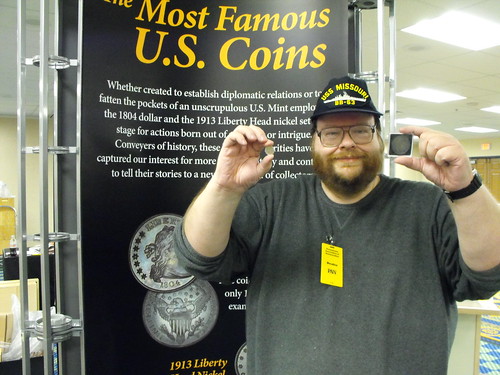
John Burns holding an 1804 dollar and a 1913 nickel (Credit: Pat McBride)
SKLOW SALE #21 CLOSES FEBRUARY 15, 2014
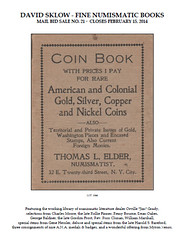 DAVID SKLOW - FINE NUMISMATIC BOOKS
DAVID SKLOW - FINE NUMISMATIC BOOKS
MAIL BID SALE # 21 CLOSING FEBRUARY 15, 2014
Featuring selections from the working library of numismatic literature dealer Orville 'Jim' Grady including very rare convention photographs of the ANA, items from the William Bareford library, the late Gordon Frost, Charles Moore, Gene Hessler, Remy Bourne, a nice offering of medals & badges of the ANA, and some very interesting items from the library of Myron Xenos.
HIGHLIGHTS
- Rare Official Convention Photographs Of The American Numismatic Association 1925-1937.
- Very Rare 1930 Silver Ana Convention Medal, Buffalo N.Y.
- Rare 1947 Three Piece Ana Convention Medal Set [Bronze-Silver-Gold], Buffalo, N.Y.
- Scarce 1910 ANA Convention Badge, N.Y.C.
- Scarce 1914 ANA Convention Badge, Springfield, Ma.
- Scarce 1921 ANA Convention Medal & Badge, Boston, Ma.
- Rare 1932 ANA Convention Badge, Los Angeles, Ca.
- Extremely Rare 1958 Special Gold-Filled Convention Badge With Gold Committee Hangar.
- Other Assorted ANA Badges & Medals, And Medal Sets From The 1920's To 1970's.
- The Art And Craft Of Coin Making By Cooper.
- Tradesmen's Tokens Of The Eighteenth Century By Atkins
- Early Issues Of The American Journal Of Numismatics 1866-1890
- Fixed Price List & Prices Paid For Lists Of U.S. Coin Dealers Volumes I, II & III By Bourne.
- Early American Car Advertisements, 1966, By Q. David Bowers.
- Q. David Bowers Numismatist: Bulletin No. 2.
- Deluxe Henry H. Clifford Sale By Bowers & Ruddy.
- Deluxe Three Volume Set Of The Norweb Sales By Bowers & Merena.
- Original Leather Bound Six Volume Set Of Annals Of The Coinage Of Britain With The Seventh Supplemental Volume, 1819 By Ruding.
- Numerous Deluxe Editions Of G.F. Kolbe Auction Catalogs In Cloth And Full Leather.
- Complete Set Of Auction Catalogs Of Joseph Levine [Presidential Coin & Antiques].
- Long Run Of Official ANA Convention Auction Catalogs [1939-1986] Privately Uniformly Bound In Black With James Thompson In Gilt.
- Deluxe Leather Numbered 114 Of 135 A Register Of Half Dollar Die Varieties And Sub Varieties By Beistle.
- Deluxe Quarter Leather World's Greatest Collection U.S. Silver Coins.
- Deluxe Quarter Leather World's Greatest Collection U.S. Gold Coins.
- Super Deluxe Full Leather World's Greatest Collection U.S. Silver Coins, With Slipcase, Inscribed To Harold Bareford By Abe Kosoff & Abner Kreisberg.
- Deluxe Quarter Leather U.S. Gold Coins And Territorial Gold - Numismatic Gallery, 1948 Inscribed To Harold Bareford By Abe Kosoff & Abner Kreisberg.
- Deluxe Bound Numbered No. 11 Adolphe Menjou Catalogue, Inscribed To Harold Bareford By Abe Kosoff & Abner Kreisberg.
- Deluxe Bound Numbered No. 4 T. James Clarke & Thomas Melish Catalogue, Inscribed To Harold Bareford By Abe Kosoff & Abner Kreisberg.
- Deluxe Bound Numbered No. 9 James Sloss Collection.
- Deluxe Bound Numbered No. 63 Edward Schwartz Catalogue, Inscribed To Harold Bareford By Abe Kosoff.
- Deluxe Bound Edwin Hydeman Catalogue, Inscribed To Harold Bareford By Abe Kosoff.
- Many Other Deluxe Catalogs From The Late Harold Bareford.
- Rare Unique Prepublication Paste Up's Of The Auction Catalogs Of Orville 'Jim' Grady.
- Complete Set Of Cal Wilson Literature Catalogs.
- Complete Set Of Cal Wilson's Numismatic Repository.
- Complete Set Of 'Out On A Limb' The Money Tree By Ken Lowe & Myron Xenos.
- Small Size Coin Cabinet, Once Belonging To Dave Hess.
- Complete Four Volume Set A History Of Banking In All The Leading Nations, 1896.
- Deluxe Full Leather California Gold Dollars, Half Dollars, Quarter Dollars, 1979 By Kenneth Lee, Published By G.F. Kolbe. With Original Purchase Receipt Of Armand Champa.
MAIL BID SALE # 22 CLOSING JUNE 15, 2014
Featuring Part One of the Library of Numismatic Literature dealer Karl Moulton, including vast runs of auction catalogs, both regular & deluxe bindings, plated sales, and long runs of periodicals.
David Sklow-Fine Numismatic Books
P.O. Box 6321
Colorado Springs, CO 80934
PH: 719-302-5686
FAX: 719-302-4933
Email:
numismaticbooks@aol.com
Web Site:
FineNumismaticBooks.com
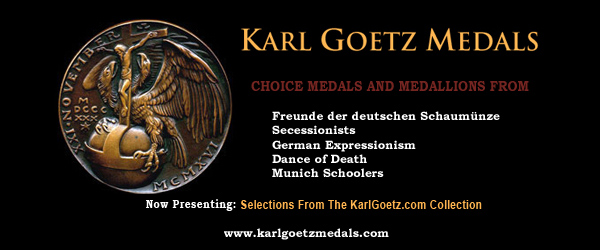
NEW BOOK: DANISH-NORWEGIAN-SWEDISH NUMISMATIC BIBLIOGRAPHY
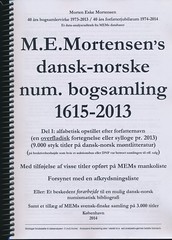 The "Catalogue of the MEM Danish-Norwegian-Swedish Private Numismatic Library 1615-2013" is now ready to be handed over to the printers, which will happen shortly (this spring).
The "Catalogue of the MEM Danish-Norwegian-Swedish Private Numismatic Library 1615-2013" is now ready to be handed over to the printers, which will happen shortly (this spring).
But first are to be collected orders from those interested parties, who may want to have the catalogue. Please write to Morten Eske Mortensen at mem@image.dk for more details.
13.166 titles registered including MEM-reference-numbers freely to be quoted by market-participants, ca. 760 A4-pages, spiral bound, weight 1,9 kilogram. (expected printing run: below 100 copies).
Economic support paid from foundations: DKK 0 / USD 0 (zero). The publishing project is instead financed e.g. by the buyers of the personal user-licences.
For more information, see: numisbooks.dk/info/demodatabankCatalogueOfTheMEMlibrary1615-2013.htm
NEW BOOK: MONETA PUBLICATION 167: HONG KONG MINT
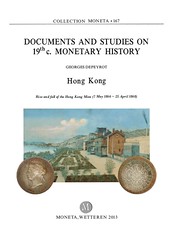 Moneta 167
Moneta 167
Documents and Studies on 19th c. Monetary History
Hong Kong
Rise and fall of the Hong Kong Mint (7 May 1866 – 25 April 1868)
Georges Depeyrot
This series of volumes Documents and Studies on 19th c. Monetary History aims to republish the main documents related to the question of bimetallism at the end of the 19th century. The series will include several sub-series devoted to the International Monetary Conferences held in various capitals during the second half of the century and to the specific situation of different countries (i.e. India, Japan, United States of America, China, etc.), since the question of monetary systems was a global one. It will also include specific studies on monetary questions and on monetary history. The scientific community will thus have access to the enormous collection of statistics, analyses and discussions on and around the subject of gold and silver coinages. These documents will be useful to specialists of the 19th century but also to all specialists in monetary history and in particular those studying the question of the ratio between gold and silver and that of the gold or silver standard, which are relevant to all periods.
The Hong Kong mint produced coins for only two years. The project was discussed for years, but by the time England and Hong Kong decided to open the plant, the economic situation was changed. The mint was never profitable and a few weeks after the inauguration, the question of the closure of the establishment was opened. For months, the master of the mint, Thomas Kinder and the Governor of Hong Kong, Sir Richard Graves MacDonnell, tried to find a solution to all the difficulties. In the final months they hoped to produce coins for China and Japan. This failed and the machines were sold to Japan to create the Osaka mint.
This volume presents the unpublished documents, letters and reports from and to Hong Kong concerning the mint. It explains why and how the mint opened and closed. It also gives information and details on the monetary situation in China and Japan.
MONETA 167
340 pages
90 euros
For more information, or to order, see: Moneta 167 (www.moneta.be/volumes/moneta_167.htm)
NEW BOOK: ROMANIA TOKENS, TAGS AND CHIPS
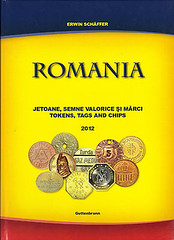 Here is another recent book on tokens from the Balkans:
Here is another recent book on tokens from the Balkans:
ROMANIA - Jetoane, Semne Valorice Si Marci, by Erwin Schäffer, 2012
The subtitle on the cover is Tokens, Tags and Chips, so I would presume the work is in Romanian and English.
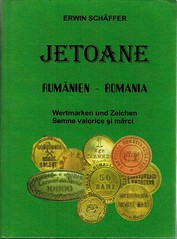 I have the 2003 edition, also attaching a photo. This marvelous Romanian-German book has 592 pages, lots and lots of photos with some in color. ISBN 973-622-073-7.
I have the 2003 edition, also attaching a photo. This marvelous Romanian-German book has 592 pages, lots and lots of photos with some in color. ISBN 973-622-073-7.
THE BOOK BAZARRE
BONHAM'S TO SELL AUGUSTIN DUPRÉ ARCHIVE
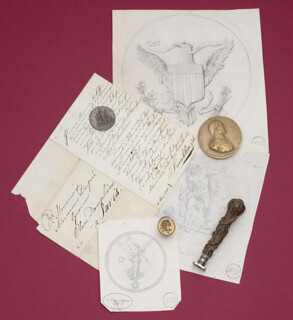 Bonhams will sell an archive of rare historical documents, coins and medals created and owned by Augustin Dupré, who was at the heart of the coin and medal design and mint operation for both Louis XVI and Napoleon Bonaparte as well as Thomas Jefferson and Benjamin Franklin.
Bonhams will sell an archive of rare historical documents, coins and medals created and owned by Augustin Dupré, who was at the heart of the coin and medal design and mint operation for both Louis XVI and Napoleon Bonaparte as well as Thomas Jefferson and Benjamin Franklin.
The collection will be on show at Bonhams in London, Paris and New York prior to a sale in New York on 2nd April 2014. It will be sold as one lot for an estimated $300,000 to $500,000.
Among the fascinating papers in this treasure trove are directions from Jefferson on how he wished General George Washington to appear on a victory coin. This and many other insights will be on offer when Bonhams sells this unique, recently discovered archive of Augustin Dupré, famed for the work he produced for Napoleon and later Benjamin Franklin, one of the founding fathers of the United States. For students of French and American history, as well as those who are fascinated by coin and medal design, this sale is a once in a lifetime opportunity to buy a piece of numismatic heritage.
This archive is fresh to the market and comprises a variety of medallions, drawings and sketches and a number of original letters from his sponsors to Augustin Dupré which provide insights into his association with the New America and the part he played in providing the first medals for the newly formed United States. The archive was inherited by his son Narcisse who passed it on to his son who gave it to the family of the current owner.
Among the rarities on sale are sketches for the Morgan Liberty, and Franklin medals among others for military figures. There is also a fascinating insight into the client artist relationship with some of the usual arguments over the cost of producing designs and medals. Thomas Jefferson makes it quite clear that he expects the designer to work to an agreed budget.
One of the most powerful documents is without doubt Jefferson's brief on what he expects the General Washington Medal to look like. Translated from the French it states: "On the one side the head of the General with the text Georgio Washington supremo duci exercitum adsertori libertatis comitia Americana. Reverse, the evacuation of Boston. The American army advancing in good form towards the city which one perceives in the distance, while the English army hurries toward the shore to get aboard the ships which fill the harbor. In front appears General Washington, on horseback, amongst a group of officers to whom he is pointing out the flight of the enemy."
It is believed that Augustin was also partly responsible for the design of one of the most powerful and internationally recognized symbols – the American eagle used on coins, medals and government buildings - which he created to his American clients specification.
John Millenstead, Director of Bonhams Coins and Medals Department, comments: "This is an amazing archive of huge historical importance, particularly to French and American collectors, both private and public institutions. But its importance is truly international, so buyers could come from any one of a dozen countries. It casts a fascinating light on the relationship between leading figures of the time as well as offering insights into the history surrounding some of the most iconic coins and medals from the period."
Augustin Dupré came from a family that included several artists and engravers and he studied as the pupil of the sculptor David. His career really took off with the French Revolution, as he became "Graveur General des Monnaies" in 1791. He successfully reinvented the look of the whole French monetary system which remained in use till the introduction of the Euro in 2000. Many of his papers are in the French national archive.
Joel Orosz writes:
Wow! And double wow! What a remarkable archive--John W. Adams will want to come out with a second edition of Comitia Americana once he sees this! Clearly, it contains a lot of Comitia material, including that Jefferson letter specifying what the Washington Before Boston medal should look like. Although the article doesn't say, I presume it will also have materials on the Libertas Americana medal that will prove once and for all that it was Dupre' who designed it. What a remarkable trove of historical material! I hope that it can be purchased by someone or by some institution who will make it available to scholars like John--it will certainly have much to teach us about the dawn of American numismatics.
It's a good thing that I have some self control, for I am tempted to go to Bonham's and lock my right arm into an elevated position for as long as it takes to win this lot. But that's where the self-control comes in, for I'm pretty certain my wife would object to my selling our cars, house, and maybe some of our kids to reel this one in.
John Bolger writes [in the Yahoo Colonial Coins Group]:
I don’t mean to step on toes or ignite a bitter philosophical debate regarding individuals versus institutions harboring artifacts, but this lot seems to be a very good fit for the American Numismatic Society. I suppose one could argue that an equivalent French institution would be more appropriate but there are limits to my willingness to allow such a treasure to stray too far.
Deep within each of us very likely lurks an inner ruthless collector as Kasper Gutman, the Fatman in search of the Maltese Falcon. Isn’t it ironic that the lead Falcon that so disappointed Kasper sold also at Bonhams for over four million dollars. The Dupre lot is indeed a thing that dreams are made of.
Tony Lopez writes:
Holy Moly! Very cool. The real question is, does it come with that 20th century John Paul Jones medal? The Heraldic eagle was designed in 1782 for use on the Great Seal of the United States (see Adams-Bentley pg.201-202), and not by Dupré.
I spoke to the folks at Bonham’s here in Los Angeles where the coin department resides, They said the lot came out of France, and is now in London being catalogued. They are selling it in New York believing (correctly) that the U.S. is the correct market for this.
I mentioned the silly photo with a restrike JPJ medal (which was done in France), and the mistaken credit given Dupré for the Heraldic Eagle design. Despite the fact that Dupré did not create the design, I explained the importance of that drawing as the design of the Diplomatic medal.
To read the complete press release, see: HISTORIC ARCHIVE OF AUGUSTIN DUPRÉ (www.bonhams.com/press_release/15534/)
AN AUGUSTIN DUPRÉ GALLERY
Libertas Americana, 1783
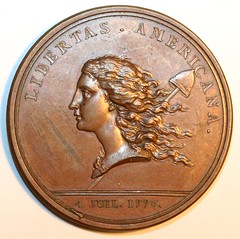

The Greene Medal, 1787

To read the complete article, see: 2011 Biggest Medals (www.coinweek.com/market-reports/2011-biggest-medals/)
The Morgan Medal, 1789
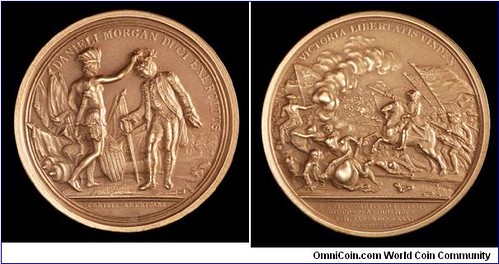
To read the complete article, see: Early American Medals (www.coinpeople.com/index.php/topic/12555-early-american-medals/page-2)
Diplomatic Medal, 1791
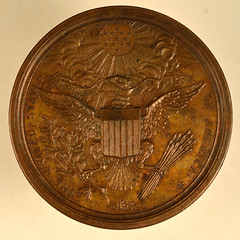
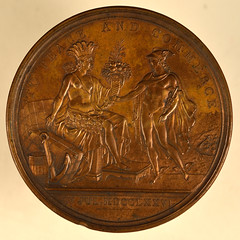
Augustin Dupré (1748–1833). Diplomatic Medal. Bronze original, 1791. Secretary of State Thomas Jefferson commissioned this medal in 1790, shortly after having returned from his service as ambassador to France. It was intended as a Gift for French diplomats who had aided the American cause. The two examples that were awarded in gold are not extant, presumably having been melted when their aristocratic recipients fled in the wake of the French Revolution. Only three examples of the original striking in bronze are known; Princeton’s specimen is the only one in a public collection.
To read the complete article, see: Augustin Dupré (1748–1833). Diplomatic Medal. Bronze original, 1791. (rbsc.princeton.edu/capping-liberty/exhibition/item/3021)
For more information, see this 1957 article on JSTOR, which may be available through your local public library:
 The Medallic Sketches of Augustin Dupré in American Collections
The Medallic Sketches of Augustin Dupré in American Collections
Carl Zigrosser
Proceedings of the American Philosophical Society
Vol. 101, No. 6, Studies of Historical Documents in the Library of the American Philosophical Society (Dec. 19, 1957), pp. 535-550
Published by: American Philosophical Society
To read the complete article, (login required) see: The Medallic Sketches of Augustin Dupré in American Collections (www.jstor.org/discover/10.2307/985522?uid=3739936&uid=2&uid=4&uid=3739256&sid=21103250610867)
WILLIAM S. APPLETON'S REMARKS ON AUGUSTIN DUPRÉ
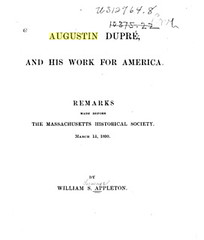 While in Paris in the early months of 1888, I had the good fortune to be of some use in securing for the Boston Public Library a group of objects which may be called the Dupre' collection. They had come from the family of the great medallist Augustin Dupre', and relate wholly to his work done for America or Americans, especially Franklin. I have been allowed to have some of the most interesting and most portable for exhibition here to-day, and will give some description of the collection, with a short account of the artist.
While in Paris in the early months of 1888, I had the good fortune to be of some use in securing for the Boston Public Library a group of objects which may be called the Dupre' collection. They had come from the family of the great medallist Augustin Dupre', and relate wholly to his work done for America or Americans, especially Franklin. I have been allowed to have some of the most interesting and most portable for exhibition here to-day, and will give some description of the collection, with a short account of the artist.
Augustin Dupre' was born at St. Etienne near Lyons, October 6, 1748, the son of a shoemaker. St. Etienne was the seat of the royal factory of arms; and as Dupre' entered in youth the employ of a gunmaker, this turned his artistic tastes and faculties in the direction of engraving on metal. At the age of twenty he walked to Paris, where he found the same employment, and soon distinguished himself by his beautiful work on sword-hilts, gradually becoming also an engraver of dies for medals.
He lived at Auteuil, not far from Franklin at Passy; and his French biographer says that his acquaintance with Franklin began in their morning walks to Paris, which one can readily accept as probable. The diplomatic philosopher undoubtedly drew from the artist's lips an account of his labors and aspirations, and was easily convinced of his ability as already shown in his works. Duvivier was at that time the principal engraver of the royal mint, and as such was employed to design the medal voted by Congress to Washington for the evacuation of Boston, — a medal of admirable workmanship, but without the least suggestion of imagination or genius. Dupre' undoubtedly felt he could do better, and Franklin gave him the opportunity.
I shall speak more particularly of Dupre's American medals later; but his merit had made him Medallist of the Royal Academy of Painting and Sculpture, and an assistant engraver for the mint, when a decree of the National Assembly of April 9, 1791, ordered a competition for designs for a new coinage. Dupre' came out victorious over all other contestants, among whom were Duvivier, the artist of the medals of Washington, De Fleury, William Washington, and Howard, Gatteaux, the artist of the medals of Gates, Wayne, and Stewart, Andrieu and Droz, also medallists of repute.
July 11, 1791, Dupre' was named principal engraver of the mint; and so continued till displaced by Bonaparte in 1803. Dupre's beautiful designs of 1791 for the pieces of twenty francs and five francs were again adopted by the short-lived Republic of 1848-1852, and are familiar to all on the coinage of France of the last twenty years, — a remarkable instance of national appreciation and popularity. Dupre' did not receive the cross of the Legion of Honor till 1830. He died at Armentieres, January 31, 1833.
His work for America and Americans comprises seven medals,— the Libertas Americana, 1783; the Greene medal, 1787; the Morgan and Jones medals, 1789; the Diplomatic medal, 1792, and two medals of Franklin of 1784 and 1786. The collection now in the Public Library contains something relating to nearly all of these.
The Libertas Americana has been the object of unbounded admiration ever since it first appeared. Some extracts from Franklin's letters concerning it may be read in Vol. XI. of the Proceedings of this Society, page 301. The conception of the young American Republic as the infant Hercules, whom France in the armor of Pallas covers with her shield, the legend being " NON SINE DIIS ANIMOSUS INFANS," of course took immensely in France; and the genius of Dupre' wrought out this idea in shape so beautiful that the medal must always rank among the choicest productions in its own department of modern art. In the Dupre' collection are proofs of both sides in gold on a white ground.
To read the complete article, see: Augustin Dupré, and His Work for America

YVES BARIL AND THE "DEVIL'S HEAD" PORTRAIT
Gene Hessler writes:
The G.A. Gundersen "devil's head" in hair of QEII was modified by Yves Baril, not Mr. Gundersen. For more information, see The International Engraver's Line. That book includes a list of most, if not all of Baril's work, which includes stamps, bank notes, stock certificates and miscellaneous engraving.
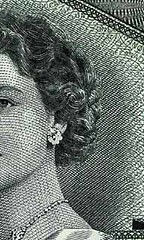
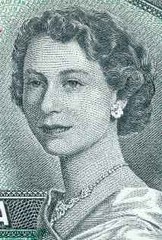
It may have been slightly embarrassing, but when his first ever stamp engraving was preferred above that of his well-established tutor, it became obvious that Yves Baril was destined to enjoy a successful career.
The engraver Yves Baril was born in Verdun, which is now part of Montreal, Quebec, in 1932. From a young age he could be seen perfecting his artistic talents. From watercolour lessons at a local library at the age of ten to the study of figure drawing under Trottier, his entire education was geared toward the arts. After graduating from the School of Graphic Art in Montreal, Baril became a pupil of the well-known engraver Silas Robert Allen, who worked at the Canadian Bank Note company.
Although such apprenticeships normally last for a decade or so, Yves was allowed to engrave his first stamp design only two years into his training, in 1955. The Canadian postal authorities, not satisfied with the quality of the engraving submitted by the master, Silas Allen, accepted Baril’s version, and found it much superior. Indeed, Baril’s engraving was used for the eventual stamp, which marked the 50th Anniversary of the Alberta and Saskatchewan provinces.
It goes without saying that this created tension between master and pupil, so maybe it was a blessing in disguise that Silas Allen died within a year or two of this incident. Not being fully qualified yet, Yves Baril perfected his engraving craft for a few more years to come, by being tutored by a number of engravers linked to the American Bank Note Company and also Bradbury Wilkinson in London
For more information on Yves Baril, see:
Presentation No 8 The Security Engravers Group
(www.cointalk.com/threads/presentation-no-8-the-security-engravers-group.82059/)
BARIL, Yves
(stampengravers.blogspot.com/2013/04/baril-yves.html)
To read the earlier E-Sylum article, see: THE 1954 “DEVIL’S FACE” CANADIAN BANKNOTES (www.coinbooks.org/esylum_v17n01a23.html)
NOTES FROM E-SYLUM READERS: JANUARY 12, 2014
Horsecar Tokens Struck by Scovill Dave Schenkman writes:
Paul Cunningham’s remarks concerning Robert Rhue’s article in The Numismatist on horse car transportation tokens are right on the money. It surprised me that the author states “In North America, only 32 types of horsecar tokens were issued by 25 horsecar lines.” Obviously there is no way to know how many types of these tokens were issued, and as Paul pointed out there is at least one type Rhue wasn’t aware of. There are possibly others; new discoveries are made from time to time.
More surprising, at least to me, is Rhue’s statement that “most, if not all” horsecar tokens were struck by Scoville (sic) Manufacturing Company of Toledo, Ohio. Scovill (note spelling) Manufacturing Company was located in Waterbury, Connecticut, not Toledo. The firm, one of America’s best known die sinkers, started striking tokens and medals in the late 1820s and was still going strong in 1952, when it issued a token marking “150 Years of Craftsmanship in Metals.”
To read the earlier E-Sylum article, see: THE DEERFIELD, MONTANA HORSE CAR TOKEN (www.coinbooks.org/esylum_v17n01a21.html)
The Most Prevalent Theme in Hobo Nickel Art Ralph Winter writes:
Myself and several other hobo nickel collectors take exception to one statement made in the article on Paolo Curcio quoted in the last E-Sylum. The statement was "Barcelona-based artist creates etched homages to pop culture, illustrations of figures from literature, and most commonly: macabre portraits of skulls and death, probably the most prevalent theme in hobo nickel art."
We take exception to "probably the most prevalent theme in hobo nickel art." That is really not the case. However, recently on eBay, there have been a plethora of skull themed hobo nickels offered for sale which Bill Rosenblum may have seen. The most prevalent hobo nickel art theme continues to be depictions of men wearing hats like three of the five of Paolo's hobo nickels pictured in the article.
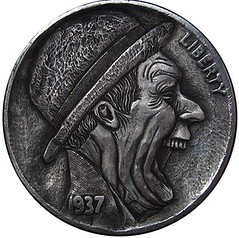
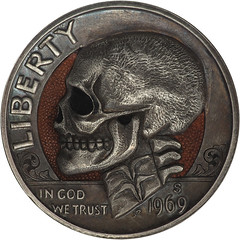
To read the earlier E-Sylum article, see: THE HOBO NICKEL CARVINGS OF PAOLO CURCIO (www.coinbooks.org/esylum_v17n01a28.html)
More on Bob Heath's State Medal Books Bryce Brown writes:
Regarding the Heath series, I have a Connecticut 7th edition, dated March 2005, in my library. It was extremely difficult to find - I doubt these were widely distributed. Mine is on standard 8.5 x 11 paper, with fairly crisp printing unlike that of a photocopy. I wonder if the format was changed since the ones Dick Johnson acquired, or if I simply have a photocopy blowup. From Bob's comments in the foreword, he seems to have been quite enthused in early 2005. I was saddened to hear he had passed the same year. In any case, there is a fair amount of "info" in the Foreword.
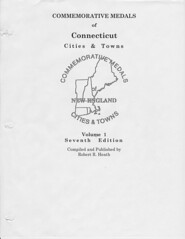
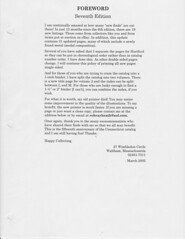
To read the earlier E-Sylum article, see: ROBERT HEATH'S NEW ENGLAND MEDAL CATALOGS (www.coinbooks.org/esylum_v17n01a20.html)
Vocabulary Word: Numismapest In jest, Dick Johnson writes:
Is a person who hounds you to go through your loose change every day a numismapest?
Query: How Many Different Denominations of U.S. coins? Jeff Swindling writes:
This seems like the kind of question that only the experts of the E-Sylum can answer..... How many different denominations of coins has the US Mint struck from 1793-present? There are at least 18, if you include circulating denominations and bullion denominations. But what if you included coins struck for other countries? Patterns? Commemoratives? For the purposes of this question, I feel like we can say that a half dime and nickel (both 5 cents) are the same denomination. Likewise, the gold $1, silver $1, and clad $1 can all be considered the same denomination.
Gasparilla Festival 110th Anniversary Medal
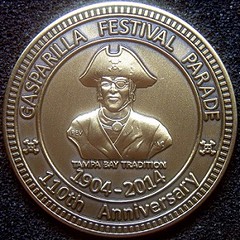 Joseph Crespo Tampa Bay Coin Club of the writes:
Joseph Crespo Tampa Bay Coin Club of the writes:
A medal celebrating the 110th anniversary of the Gasparilla Festival has been commissioned by the Tampa Bay Coin Club through a private Mint. Since the 50th anniversary token [HK-720a] struck in 1954, this event has never been honored with any other piece.
For more information, see: Club Medal Program (tampabaycoinclub.org/Club_Medal_Program.html)
PRESIDENCY RELINQUISHED MEDAL RESTRIKE REVISITED
Regarding the headline of last week's article by Tony Lopez (ARTISTIC STYLE REVEALS MAKER OF SANSOM MEDAL RESTRIKE), Joe Levine writes:
Am I misreading this? I think Tony is referring to the identity of the maker of Betts 34-36, not the Sansom medal.
Kay Olson Freeman writes:
No where mentioned is the maker of the 1859 reissue. Presumably, it was James B. Longacre who made new dies based on original medal?
Tony Lopez writes:
Yes, I agree as Joe and Kay point out that I have not identified the maker of the Sansom Restrike as the title stated! Just determined that the 1859 + restrike was not struck with the original Sansom dies as stated in Rulau/Fuld, and equally important that the originals are the only medals struck with original dies. Maybe a title like “Using ‘Artistic Style’ research method proves 1859 Sansom restrikes were not struck with original obverse die”?
Bob Julian writes:
I read with interest the discussion, in The E-Sylum of January 4, by Tony Lopez on the Presidency Relinquished medal. Unfortunately Mr. Lopez was unaware that the “restrike” dies of 1859 were in fact hubbed from the original dies. The dies prepared by John Reich were kept at the Mint by Adam Eckfeldt and then Franklin Peale; the latter wrote in 1854 that the “dies [are] rusted and destroyed but capable of restoration by hubbing.” In the hubbing process, however, the lettering is not copied and has to be redone on the replacement dies. The minor differences in the motifs can be ascribed to the dies being touched up in the engraving department.
Tony Lopez writes:
As far as the 1859 dies being hubbed from the original dies, other than Peale’s conjecture that the dies are “capable of restoration by hubbing” 5 years earlier, are there any records specifically stating that this hubbing of designs from the originals actually took place in 1859? Also, was the reverse design (sans lettering) also hubbed from the original Sansom reverse? Ultimately, if evidence is provided, I would defer to Bob Julian as he did all of the incredible first person research at the US Mint for the opus magnum Medals of the United States Mint and has a plethora of knowledge about all of these medals far beyond my own.
It is difficult to know this connection though, as in the PR-1 Presidency Relinquished listing Julian states only that the 1859 dies (plural) were hubbed from the originals “according to Baker”, and does not mention his own knowledge of this connection between originals/restrikes in the reference, or that the designs (not lettering) were hubbed from the original Sansom dies which are described as viable by Peale in 1854.
In light of Baker’s important inaccuracies about these medals nearly a century earlier- such as the wrongful belief that Halliday preceded Sansom (which Julian points out in detail is incorrect); given the differences in the designs of the restrikes, relying alone on Baker about the hubbing from original dies is questionable.
Nothing in this statement is meant to take away from Bob Julian’s undertaking, which was monumental (and as Bob and Joe Levine both know was monumental personally in inspiring me to collect and research historical medals in the first place). Still, with the differences in the medals proving that the obverse is not original as stated in Rulau/Fuld, and the documented connection between the original and restrike dies still having a five year gap, I for one need to know the missing piece to make the connection. But it is possible now if you exclude the lettering. There are still many differences, as noted, and whether minor or not, they are certainly noteworthy.
One interesting aside I noticed in Peale’s statement. What we today commonly refer to as “restrikes” or “restrike dies”, Peale describes as a “restoration”. The word “restrike” (and restrikes, restriking, restruck) gets flagged by my word processing and e-mail programs as a misspelling! Maybe we should adopt Peale’s terminology “restoration” to keep our computers happy?
To read the earlier E-Sylum article, see: ARTISTIC STYLE REVEALS MAKER OF SANSOM MEDAL RESTRIKE (www.coinbooks.org/esylum_v17n01a11.html)
THE BOOK BAZARRE
BRASHER DOUBLOON REALIZES $4,582,500 AT HERITAGE AUCTION

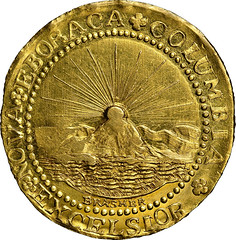
To understand the importance of the Brasher doubloon it is necessary to know something about its creator, a multi-faceted man named Ephraim Brasher. Brasher was a man of many accomplishments and fairly well known in his time, but history had largely forgotten him until scholars began researching his life in conjunction with his numismatic legacy. Much has been learned about Brasher and his coins in recent years, but some questions remain unanswered.
Ephraim Brasher, Silversmith, Patriot, and Businessman
Ephraim Brasher, the originator of the Brasher doubloons, was an American patriot and silversmith, like his more famous contemporary, Paul Revere. He was born April 18, 1744 to an old Dutch family in New York. Different branches of the family spelled their name variously as Breser, Bresert, Brasier, Brazier, and even Bradejor. His lineal descendants reveal that the preferred pronunciation is Bray-zher, but most present-day numismatists and the general public have always pronounced it phonetically (hopefully causing no unintended offense to the illustrious family). Brasher lived all his life in New York City.
One of Brasher's chief claims to fame was that he lived just a few feet from President George Washington in New York City after the war. Washington resided at 3 Cherry Street and Brasher lived next door at 1 Cherry Street.
Not only were Washington and Brasher neighbors, but Washington was also a customer of Brasher. He owned numerous silver pieces made by Brasher, including a number of silver skewers with a surviving receipt. It was certainly important for Washington to make a good impression at state dinners, which he did with the assistance of his Brasher silver.
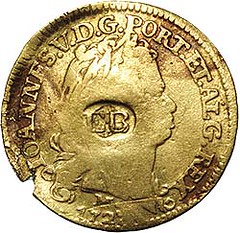 A number of foreign gold and silver coins are known today that bear Brasher's trademark counterstamp. It is thought that Brasher evaluated these coins and stamped them to signify that they were of full weight and fineness. The Bank of New York employed gold and silversmiths, like Brasher, to test the coins that came into the bank. These men were known as "Regulators" and they would weigh each coin as it was deposited and add a plug of gold to any that were found to be outside the allowable tolerances, stamping the coin with their stamp to indicate that the coin was of proper weight and consistency. These coins are highly regarded and sought-after by collectors today. Brasher's reputation as an assayer was apparently well-established by the late 1780s, and his counterstamp was widely accepted as a guaranty of value.
A number of foreign gold and silver coins are known today that bear Brasher's trademark counterstamp. It is thought that Brasher evaluated these coins and stamped them to signify that they were of full weight and fineness. The Bank of New York employed gold and silversmiths, like Brasher, to test the coins that came into the bank. These men were known as "Regulators" and they would weigh each coin as it was deposited and add a plug of gold to any that were found to be outside the allowable tolerances, stamping the coin with their stamp to indicate that the coin was of proper weight and consistency. These coins are highly regarded and sought-after by collectors today. Brasher's reputation as an assayer was apparently well-established by the late 1780s, and his counterstamp was widely accepted as a guaranty of value.
Brasher's Private Coinage
Brasher's skill as a silversmith, engraver, assayer, and metal worker enabled him to branch out into the field of private coinage for which he will always be remembered. His first endeavor in the field seems to have been the Lima Style doubloon, which resembled the widely circulated 1742-dated Spanish coins of the 8 Escudos denomination. The 8 Escudos coins were called Doblons in the Spanish colonies and the term was adopted and Anglicized to doubloon in the United States. They were worth $16, a large sum for the average man in the late 1700s.
The New York Style Doubloons
Brasher created his numismatic masterpiece, the New York Style Brasher doubloon, sometime in 1787. Although the specifications for the coin are virtually identical to the Lima doubloons and are extremely close to those of the earlier Spanish coins that served as their prototype, the design was something altogether new:
Obverse: The obverse was apparently adopted from the state coat of arms of New York. The sun is rising over the peak of a mountain with a body of water in the foreground. Brasher's name is spelled out below the waves, in small letters. This central device is enclosed within a circle of beads. The legend, around: NOVA EBORACA COLUMBIA EXCELSIOR has each word separated by a rosette. The legend translates to New York, America, Ever Higher. Excelsior remains the state motto to this day.
Reverse: An eagle with wings displayed, and a shield covering its breast, has a bundle of arrows in its sinister claw (to the observer's right) and an olive branch in its dexter claw. Thirteen stars surround the eagle's head. This central device is enclosed in a continuous wreath. Around, the legend: UNUM E PLURIBUS with the words separated by stars. This legend translates to One of Many. Below, the date 1787 is flanked by rosettes. Many of these devices are similarly used on the Great Seal of the United States. Like many coins of this era, the denomination was not specifically expressed anywhere on the coin.
To read the complete lot description, see: 1787 DBLN Brasher Doubloon, EB on Wing, W-5840 (coins.ha.com/c/item.zx?saleNo=1201&lotIdNo=79001)
To read the Coin Update article, see: Finest Certified 1787 Brasher Doubloon Realizes $4,582,500 (news.coinupdate.com/finest-certified-brasher-doubloon-auction-result-3100/)
GREENBACK BACKER ELDRIDGE G. SPAULDING'S BANKNOTE
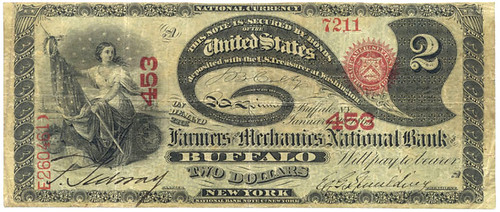
Peter Huntoon writes:
The brief piece in the January 5, 2014 E-Sylum on the origin of Civil War greenback currency thrust Eldridge G. Spaulding, Congressman from New York, into the your limelight. He left a fabulous numismatic legacy in the form of this lazy deuce that your readers will be certain to drool over. This attractive note from Buffalo is particularly significant because of the penned president’s signature of Eldridge G. Spaulding.
Spaulding, a New York Republican Congressman and member of the House Subcommittee of Ways and Means, was the first in Congress to attempt to introduce national currency legislation on behalf of Secretary of the Treasury Salmon P. Chase, which he did in 1861. Spaulding’s bill died under the weight of opposition from Thaddeus Stevens, Republican from Pennsylvania and chairman of the House Ways and Means Committee. Spaulding then introduced legislation that did pass that authorized the Legal Tender notes (greenbacks) in 1862. He organized the Buffalo bank after leaving Congress. Photo courtesy of Jesse Lipka.

To read the earlier E-Sylum article, see: THE BIRTH OF THE GREENBACK (www.coinbooks.org/esylum_v17n01a25.html)
COLLECTING CITY OF NEW ORLEANS SCRIP
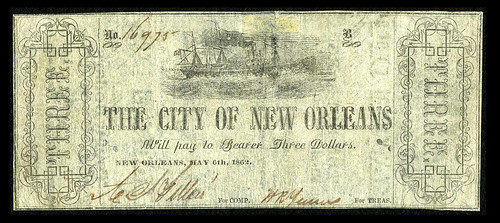
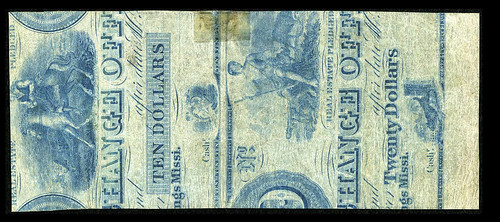
$3 note printed on the backs of Holly Springs, Mississippi bank notes
Let’s go back to April, 1862 and visit the situation in New Orleans. As was the case almost everywhere else, coins had disappeared from circulation as the realization grew, both north and south, that this was not going to be a war that would be concluded in a matter of weeks or months, but rather years. In another confirmation of Gresham’s Law (“bad money drives out good”) by late 1861, New Orleans was awash in chits and scrip notes issued by literally hundreds of merchants, shopkeepers, and even omnibus lines in an attempt to continue commerce.
The city finally officially surrendered during the course of April 28-29, and General Benjamin Butler’s first infantry units entered the city on May 1, 1862.
The city council took measures to instill public confidence in the myriad private shinplasters and other so-called “small notes” (typically in fractional and dollar denominations of less than $5). On April 28, 1862 the Committee for Public Safety published a list of thirteen issuers, including the Confederate government, the state of Louisiana, and the cities of Baton Rouge and New Orleans. On May 3, the Mayor stated that the city would redeem all shinplasters and small notes and on May 6, the Committee for Public Safety added another seventeen issuers to its “approved” list. Later that same evening, five days after Union troops occupied the city, the city council passed an ordinance which created a formal process for stopping further private issues and redeeming those already in circulation.
by May 19, 1862, issuers had two options for redeeming their notes. They could participate in the city’s program or comply with the federal order. The city continued with its program. One printer, J. Douglas, printed 25ȼ, 50ȼ, and $1 notes for the city’s program while another printer, Isaac T. Hinton printed the larger $2, $3, and $4 denominations. All were dated May 6, 1862.
Later in 1862, a new series of notes dated October 24, 1862 was issued to redeem the May 6th notes and in October, 1864 a final issue of $20s was made to redeem the earlier notes.
Wendell adds:
New Orleans is turning out to be a fascinating paper money locale. Lots of characters and stories beyond the boredom of Canal Bank remainders. There were over 125 scrip issuers in the city alone; far more than in any other city in the Confederacy. Lots of research yet to be done.
To read the earlier E-Sylum article, see: QUIZ ANSWER: CITY OF NEW ORLEANS (www.coinbooks.org/esylum_v16n53a08.html)
EMPLOYMENT OPPORTUNITY!
Live and Work in Southern CaliforniaStack’s Bowers Galleries offers an important employment opportunity for the right person. We are seeking an experienced numismatist in the American series—coins, tokens, medals, and paper money—to work with our “dream team” of catalogers, building on the tradition of the Ford, Eliasberg, Bass, Cardinal, Norweb, Battle Born and other great collections.
If you can write in an authoritative and compelling manner with a high degree of accuracy, this may be just right for you! You will be working in Irvine, a modern community in dynamic Orange County, California—one of the finest areas to live. We offer generous benefits including medical and dental coverage, 401K plan, and more. Our offices are in our own modern, state-of-the art building with all amenities.
If you would like to be considered for this position please contact Q. David Bowers by mail or by email with your resumé, samples of your past writing (on numismatics or other subjects), and salary requirements: Mail to the attention of Q. David Bowers, PO Box 1804, Wolfeboro, NH 03894. Email to: Ckarstedt@stacksbowers.com
MORE ON THE DEERFIELD, MONTANA HORSE CAR TOKEN
I greatly enjoyed Paul's piece on the Deerfield token in the last issue of The E-Sylum. Here are two more ideas for confirming the existence of this horse car line:
1. I believe even back then the states may have had the equivalent of Public Service Commissions that licence street railways.
2. Maybe a county or state historical library could turn up some mention of a street railway for Deerfield. That's not something that happens every day.
After sitting in front of this screen for a couple of hours, I came up with a little information that may be of interest.
R.L. Polk & Co. of Helena, published their first Lewiston City Directory and Fergus County Directory in 1904. The listings for Deerfield, Montana, are on pages 129-130.
"A country postoffice on the Judith river, first settled 1887, 25 miles northwest of Lewiston, the banking and shipping point, Jesse Sampler; postmaster." A list of 23 residents follows without any A. Myers.
IMHO the token is a mule. Deerfield, Montana, could not even think of supporting a horse car line.
Paul Cunningham adds:
Yosef also correctly pointed out that the last edition of the Atwood-Coffee Catalogue is the 2007 Sixth Edition (I'd cited the Seventh edition in my earlier post).
The one problem I have will live on - if it's a mule, then show me the die or another token that was struck with the die.
To read the complete article, see: THE DEERFIELD, MONTANA HORSE CAR TOKEN (www.coinbooks.org/esylum_v17n01a21.html)
MORE ON COUNTERFEITS, REPLICAS AND FANTASIES
Howard Daniel writes:
I cannot remember if I have written to you about my definitions for Counterfeits, Replicas and Fantasies, so here it goes (again?).
For my catalogs, a Counterfeit is a unofficial copy of an authentic circulating coin, note, token, etc., that was made during the time it could be spent and was made to be spent.
A Replica is an official or unofficial copy of an authentic circulating coin, note, token, etc., that was made after the time it could be spent and was made not to be spent.
A Fantasy is a coin, note, token, etc., that was made with a design that never existed in authentic or replica form and was made to spend in some cases, but is usually made for collectors.
All of my catalogs now have a chapter titled Counterfeits, Replicas and Fantasies. It is very popular with the collectors here in Southeast Asia because 99% of the catalogs they have seen before have none of these pieces in them.
For me, the 1804 Dollar and the 1913 Nickel are authentic coins because they came from an official source (mint) and could be spent after they were struck.
Speaking of catalogs, I just completed my Lao Coins & Currency catalog and it could be in print by the end of the month. One of your subscribers, Fred Schwan, will be grinding his teeth when he sees the title. He has been after me for years to change the title of my catalogs because "currency" includes coins and notes. Sorry......too late Fred.
To read the earlier E-Sylum articles, see:
STEVE D'IPPOLITO ON NOVODELS AND FANTASY PIECES
(www.coinbooks.org/esylum_v17n01a15.html)
LIBERTY DOLLARS, LEGAL OPINIONS, AND TEST CASES
(www.coinbooks.org/esylum_v15n54a08.html)
HOWARD DANIEL ON FAKES IN NUMISMATICS
(www.coinbooks.org/esylum_v16n20a19.html)
PETITION QUESTIONS FIRST WORLD WAR CENTENNIAL COIN
David Pickup writes:
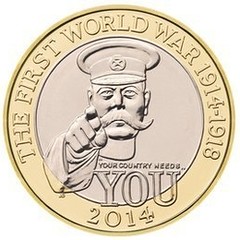 Readers might be interested that a petition has been started to get the Royal Mint to change the new Two Pound Coin design for the 100th Anniversary of the start of the First World War.
Readers might be interested that a petition has been started to get the Royal Mint to change the new Two Pound Coin design for the 100th Anniversary of the start of the First World War.
The design has been criticised on a number of grounds including that it is a poor representation of the Kitchener poster and that another design would be better.
I think it is the right image to use as it captures the mood of eagerness to volunteer in 1914 but it is not a very good copy of the famous poster.
I do not know if the US is planning a similar coin or what image would be appropriate.
The new £2 coin featuring Kitchener does nothing to commemorate the millions of people who died in world war one. We urge you to replace the Kitchener coin with one that truly commemorates the dead. If there is not time for this, we ask you in any case to withhold the Kitchener coin from circulation.
To visit the petition page, see: Royal Mint: Replace the Kitchener £2 coin with one that truly commemorates the millions who died in the first world war (www.change.org/en-GB/petitions/royal-mint-replace-the-kitchener-2-coin-with-one-that-truly-commemorates-the-millions-who-died-in-the-first-world-war)
Below is information on the original poster from Wikipedia.
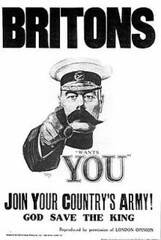 A 1914 recruitment poster depicting Lord Kitchener, the British Secretary of State for War, above the words "WANTS YOU" was the most famous image used in the British Army recruitment campaign of World War I. The poster appeared as the cover illustration for London Opinion magazine on 5 September 1914, and The Times recorded the scene in London on 3 January 1915; "Posters appealing to recruits are to be seen on every hoarding, in most windows, in omnibuses, tramcars and commercial vans. The great base of Nelson's Column is covered with them. Their number and variety are remarkable. Everywhere Lord Kitchener sternly points a monstrously big finger, exclaiming 'I Want You'". A hugely influential image and slogan, it has inspired imitations in other countries, from the United States to the Soviet Union.
A 1914 recruitment poster depicting Lord Kitchener, the British Secretary of State for War, above the words "WANTS YOU" was the most famous image used in the British Army recruitment campaign of World War I. The poster appeared as the cover illustration for London Opinion magazine on 5 September 1914, and The Times recorded the scene in London on 3 January 1915; "Posters appealing to recruits are to be seen on every hoarding, in most windows, in omnibuses, tramcars and commercial vans. The great base of Nelson's Column is covered with them. Their number and variety are remarkable. Everywhere Lord Kitchener sternly points a monstrously big finger, exclaiming 'I Want You'". A hugely influential image and slogan, it has inspired imitations in other countries, from the United States to the Soviet Union.
To read the complete article, see: Lord Kitchener Wants You (en.wikipedia.org/wiki/Lord_Kitchener_Wants_You)

QUERY: YEATMAN & ARMISTEAD TOKEN INFORMATION SOUGHT
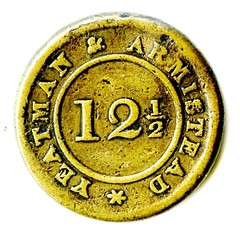
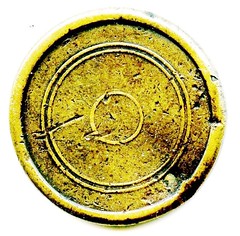
Among the tokens I acquired from the estate of Steve Tanenbaum was one on which he was doing research before his untimely passing. It is struck in brass, 23 mm in diameter, and is illustrated here. The 12 ½ denomination is equal to that amount in cents, or one real or “bit” in Spanish-American coins, many examples of which were circulating in the United States in the 1830s and 1840s, the era of this token.
I have been trying to track down information about Yeatman & Armistead, the issuer, who was based in Nashville, Tennessee. The numismatic importance is that at present there are no known Hard Times tokens from that state, in the years from 1832 to 1844 as defined as the Hard Times token era by Lyman H. Low.
Although Steve’s notes say that he found information in the Tennessee Telegraph, November 21, 1840, page 3, I have not been able to track down a copy on the Internet. We do know that the partners were Henry T. Yeatman, of a famous Nashville family, and William B. Armistead, who was born in Nashville in 1811, of whom I have been unable to track down information from the HTT era, although later information when he conducted Armistead & Co. is plentiful. Yeatman & Armistead had a large warehouse and a steamer landing.
In the 1837-1838 edition of Longworth’s American Almanac: New-York Registry and City Directory the Yeatman & Armistead branch dry goods store was at 34 Cedar Street, but it does not seem to have lasted long. No home addresses were given for the principals as they lived in Nashville. In the 1850s there was the law = case of Yeatman v. Armistead of which I seek information as well. Later each went into a separate business. If anyone has any further information I would be very pleased to learn more!
This will be part of a new book on Hard Times tokens that I plan to complete in 2014. I began the manuscript in the 1970s! I would also appreciate hearing from anyone with a deep research interest in HTT as I have other questions, new discoveries, and the like.
EARLIER COIN DEALER PHONE NUMBERS FOUND
A couple issues ago, Pete Smith issued a challenge to E-Sylum readers to come up with any earlier use of a phone number on a coin dealer catalog than Edgar Adams' 1913 listing.
John L. (Jack) Howes writes:
I was browsing a copy of The Numismatist from April 1910. Henry Chapman has a number listed for him as Bell Telephone, Walnut 2019. This was the only ad in the issue with a phone number including another full page ad by his brother S.H. Chapman.
I looked further in some e-versions I have of The Numismatist. I found that in September 1908, Thomas Elder advertised his telephone number in one ad -- Grammercy 5899. It appears he dropped his number from subsequent ads. In the same issue, a company that went by the name of Divver from Atlanta had a number of North 1190. Henry Chapman did not start using a phone number until Jan 1909.
There may yet prove to be an earlier reference to a dealer phone number, but for now this 1908 Elder listing is the reigning champ. Thanks! -Editor
To read the earlier E-Sylum article, see: THE EARLIEST COIN DEALER PHONE NUMBER? (www.coinbooks.org/esylum_v16n53a14.html)
PUNCTUATION PUGILISM PERSISTS
Last week Fred Schwan wrote:
Anyway, to me the humor to me was the incorrect American use not only in a discussion of punctuation use, but also in a phrase with the word Oxford!
Martin Purdy writes:
I should probably point out to Fred that I'm not American, so the punctuation for me goes outside the quote mark unless the entire sentence is a quotation (and one or two other minor exceptions that I won't go into here). Same as with punctuation and brackets, on reflection.
Mark Borckardt writes:
I believe that Fred Schwan’s Oxford comma sentence should have been written “’Oxford comma’,”
Philip Mernick of London writes:
Having been on holiday for a while I have picked up this subject a bit late. Just in case you are still not totally fed up with the subject, here is the opinion of Elina Screen, deputy editor of The British Numismatic Journal.
Elina Screen writes:
This is one where I don't think there's a single "right" answer. The inclusion of the final comma in a list before the "and" is sometimes also called the "Oxford comma". The BNJ follows the Modern Humanities Research Association guidelines, sometimes slightly tweaked. This does advise including the last comma (styleguide pp. 33-4, which can be downloaded free here: www.mhra.org.uk/Publications/Books/StyleGuide/download.shtml ).
But as the guide points out, the golden rules are internal consistency and clarity to the reader. So, providing the meaning was clear and the author had either consistently included or excluded the comma, personally I'd not change it. I think this usage is more about personal preference rather than having much grammatical significance.
Bob Evans writes:
I place myself firmly in the camp using the Oxford comma, when it is proper.
Kudos to you for use of 1930s! 1930's is only correct when referring to something pertaining to the year 1930, such as 1930's best movies.
My personal, understandable pet peeve over the use of the apostrophe appears to be a losing battle in recent decades, but it is one I will fight to my demise. This is the dropping of a second "s" when using the possessive form of a name ending in "s," such as Evans. This is Evans's opinion. If it were Evans' opinion I would wonder, "Just who are these Evans?"
On 1930s:
Q. I have suddenly become an editor and am having trouble on a daily basis with the numeric use of decades. First, is “the 90s” or “the ’90s” correct? We often see the apostrophe omitted these days. Next, if a sentence contains the phrase, “Perhaps the 70s best director . . .” (meaning, the best director of that decade), “70s” is both plural and possessive. Should it be “70’s”? “70s’”? Other than reconstructing the sentence, what’s an editor to do?
A. Strictly speaking, ’90s, with the apostrophe, is correct.
The ’70s’ finest director was Martin Scorsese, particularly for his work on Alice Doesn’t Live Here Anymore and Taxi Driver.
Note the apostrophes, both of them. You are always free to write “seventies’ finest.” Or, “The finest director of the ’70s was assuredly Francis Ford Coppola, for his work on the first two Godfather films and Apocalypse Now.”
On Evans's:
Q. When indicating possession of a word that ends in s, is it correct to repeat the s after using an apostrophe? For example, which is correct: “Dickens’ novel” or “Dickens’s novel”?
A. Either is correct, though we prefer the latter. Please consult 7.15–18 for a full discussion of the rules for forming the possessive of proper nouns. For a discussion of the alternative practice of simply adding an apostrophe to form the possessive of proper nouns ending in s, see paragraph 7.21.
To read the complete article, see: Possessives and Attributives (www.chicagomanualofstyle.org/qanda/data/faq/topics/PossessivesandAttributives.html)
I asked numismatic author Dave Bowers, who writes:
Whitman Publishing uses the Chicago Manual. What I normally do is add an extra 's' if the word is short, not if it is long:
- Jones’s house is painted purple
- Aristotle Onassis’ yacht is for sale
Speaking of Dave's new book, I understand The Whitman Guide Book of Civil War Tokens has been a best seller and will be sold out within a month or two. A new edition is planned. -Editor
Dave forwarded our exchange to editor Amanda deWees at Whitman, who adds:
Current usage (including that recommended by the Chicago Manual, but not exclusive to it) is to add the ‘s’ to form the possessive of singular names ending in ‘s’ (e.g., Maria Callas’s gown), with possible exceptions for (a) names ending in an “eez” sound, like Aristophanes (e.g., Aristophanes’ tuba) and (b) biblical names like Jesus and Moses (e.g., Moses’ cardigan), just because tradition for these has always been to use just the apostrophe.
What really baffles and vexes me these days is to see people use the apostrophe to make plurals and the plural form instead of the possessive. I do not get this at all.
Steve Woodland writes:
I have really enjoyed the ongoing discussion on comma usage. Your readers may wish to read Michael Leddy’s blog on punctuating sentences with commas: http://mleddy.blogspot.ca/2007/04/how-to-punctuate-sentence.html .
To read the earlier E-Sylum article, see: STILL MORE ON THE SERIAL COMMA (www.coinbooks.org/esylum_v17n01a14.html)
ABOUT THE AUTHOR: STARR GILMORE
Robert Rightmire writes:
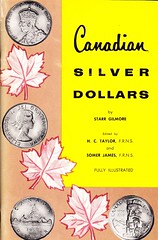 Last January you posted my request for information about Starr Gilmore, the author of Canadian Silver Dollars, 1961. Very little information on Gilmore was forthcoming. Darryl Atchison did provide a very useful bibliography of his journal writings. Since then I was able to purchase the author’s manuscript for Canadian Silver Dollars. Gilmore wrote an “About the Author” biographical sketch that was edited out of the book. I’ve retyped it, exactly as written, for our readership.
Last January you posted my request for information about Starr Gilmore, the author of Canadian Silver Dollars, 1961. Very little information on Gilmore was forthcoming. Darryl Atchison did provide a very useful bibliography of his journal writings. Since then I was able to purchase the author’s manuscript for Canadian Silver Dollars. Gilmore wrote an “About the Author” biographical sketch that was edited out of the book. I’ve retyped it, exactly as written, for our readership.
Any information on Gilmore, after 1964, is again requested. Does anyone have a photo of him? It could be of a group from a convention, etc. Also, any information from an obituary would be very helpful to my research.
I was born on a large farm near Potlatch, Idaho, on August 6th, 1903, and I took to farming in the same manner that a cat takes to water. In those benighted days, transportation being what it was, and a heavy rainstorm having occurred, the doctor ambled out to my ancestral home with something in the nature of a horse and buggy, rather late in the morning, and much too late to do any good. Nevertheless, he saw fit to make a charge for services which was indignantly refused. Born protesting, I am still doing it, and I am still at heart a rebel.
My ancestry is English and Norwegian, mostly the former, and the great majority of my people on the paternal side live in the South. My lineage, such as it is, has nothing about it aristocratic and I am a son of the people, a thing which troubles me not a whit.
Honors in debating and oratory. Graduate of Washington University with an M.A. in history and English. Some newspaper reporting experience. Alternated between welfare work and teaching and finally learned to dislike both. Private tutor in Mobile, Alabama, and taught mostly very small ladies who aspired to the Southern belles. Teaching of this kind I liked.
No conventional home of any kind although I try to make one wherever I find myself. Extremely cosmopolitan in outlook, I have a strong tendency to look upon most accepted social patterns with active dislike. Poet, essayist, and short story writer. I write fluently in the French verse forms and have a special interest in epigrams.
Mobile has one tiny coin shop and my interest in coins began with it. Much to my astonishment, I learned for the first time about United States commemoratives and then wondered how it was possible to live in a country and know so little about its coinage. I still wonder but not quite so much.
A Mobile tradesman refused a coin from me because he declared it was Canadian. It wasn’t , but it was enough to start an interest in Canada which has never ceased. A shift of interest from American dollars to those of the Dominion came about easily enough. Vaguely, and as I imperfectly remember, I first heard of them in 1945.
As might be supposed, my primary interests are those of a scholar and research worker and I have studied homonyms and heteronyms in particular detail, enough to make possible a book. The subject was last written on in 1873. Flowers fascinate me, especially their genetics, and especially those relating to iris and carnations. Unmarried, I live in such solace as this condition of life is able to afford.
Starr Gilmore September 20, 1959
Spokane, Washington
To read the earlier E-Sylum articles, see:
QUERY: INFORMATION ON AUTHOR STARR GILMORE SOUGHT
(www.coinbooks.org/esylum_v16n01a22.html)
CORRECTION: STARR GILMORE BIBLIOGRAPHY
(www.coinbooks.org/esylum_v16n02a13.html)
THE BOOK BAZARRE
DICK JOHNSON: ANA HALL OF FAME FALLS FLAT
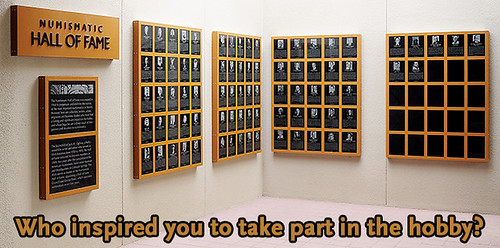
The ANA sent an illustration this week to its members of its wall containing the portrait image of all the Hall of Famers of the numismatic field.
However the wall falls flat -- each portrait is flat -- I can't tell if the image of every prominent numismatist is a photograph or some other permanent form. But they are all uniformly flat.
It may come as a surprise to the designers of this wall that numismatics is a study of RELIEF. -- images that rise from their background. like the design of most every coin, medal or token rises from its background.. Only paper money in numismatics is a study of flat images.
How much better -- more fitting and appropriate -- it would have been to have a RELIEF PORTRAIT of each of the Hall of Fame winners.
Surprise! It could even utilize that RELIEF PORTRAIT as the image -- as the model -- for a medal. A series of famous numismatists of the field issued by ANA would make an ideal theme for a numismatic series. Marketing such a collectors set would be a dynamic method of raising funds for the association.
For more information on the ANA Hall of Fame, see: Numismatic Hall of Fame (www.money.org/membership/awards/numismatic-hall-of-fame.aspx)
JOHN MERCANTI DESIGNS AUSTRALIAN EAGLE COIN REVERSE
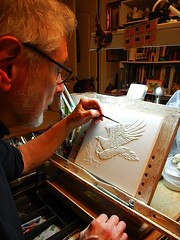 The Perth Mint is delighted to announce that the 12th Chief Engraver of the U.S. Mint has created the magnificent reverse for our new Australian Wedge-Tailed Eagle gold and silver high-relief proofs.
The Perth Mint is delighted to announce that the 12th Chief Engraver of the U.S. Mint has created the magnificent reverse for our new Australian Wedge-Tailed Eagle gold and silver high-relief proofs.
One of America’s most respected coin sculptor-engravers, John Mercanti joined the U.S. Mint in 1974, holding the position of Chief Engraver from 2006 until his retirement in 2010. His achievements are remarkable - with the coin and medal design process traditionally a competition between members of the in-house team, John is responsible for more successful designs than any other employee in the history of the U.S. Mint.
Among them is the American Eagle silver coin, first issued in 1986. Featuring John’s re-interpretation of ‘Walking Liberty’ and a stunning heraldic eagle on the reverse, “the coin that started it all” was a landmark release in U.S. history.
John brought his extraordinary talents to bear on the Australian Wedge-Tailed Eagle project on behalf of The Perth Mint. Despite being honoured for so many outstanding achievements in American coin design, he is kind enough to describe the opportunity to sculpt the image for an Australian legal tender issue as “one of the highlights of my career.”
The eagle is traditionally a symbol of freedom, spirit, vision and strength, one which still inspires him from a design perspective. His immediate thought was to present it in an original way: “I asked myself, how could I use the same subject that's been used before but depict it differently and make it interesting?”
The Wedge-Tailed Eagle is Australia’s largest bird of prey and one of the biggest eagles in the world. Defining characteristics include its huge wingspan, fully feathered legs (in contrast to its North American cousin, the Bald Eagle) and, of course, its wedge-shaped tail.
There is no doubting the power and splendour of this mighty bird from John’s superb portrayal. To satisfy the requirement for a unique viewpoint, he chose to capture an eagle preparing to land on the branch of a dead tree. “I decided to show the eagle in flight, approaching the stump, wings spread so that the viewer could see the majesty of the wings,” he elaborates.
The beauty of the design is enhanced by John’s stunning representation of the eagle’s intricately layered feathers. Conspicuous against an uncluttered, mirror-like table, the crisp, high-relief strike maximises an onlooker’s appreciation of this immense detailing.
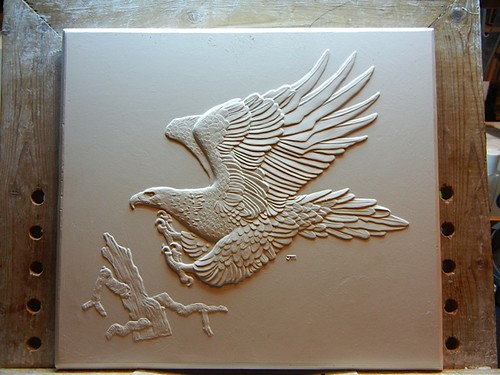
For more information, see: www.perthmint.com.au/
WORTHLESS ZIMBABWE NOTES RISE IN PRICE
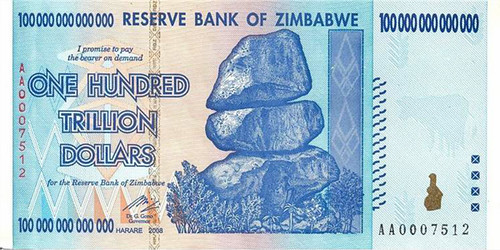
Can you name the numismatic item trading for less than $50 that has more than doubled in price in the past six months?
If you named the Zimbabwe Series 2008 100 trillion note in uncirculated condition, give yourself a pat on the back.
What was once just a warning against the perils of hyperinflation has now become a sought-after collectible in its own right.
The Zimbabwe note was demonetized in January 2009 when that nation’s currency failed. For a time, it could still be used to pay for a single bus fare, but not any longer.
The note has the distinction of being the highest denomination coin or paper money issue ever. Right after they became worthless, this note became an instant hit as a novelty item to the general public, especially since the denomination was stated in “dollars.” My company has sold hundreds of them every year. Initially, we were selling uncirculated specimens for $3 apiece.
As time went on, supplies became scarcer. By the end of 2013, we were retailing these for $7.99 each. But not any longer.
These notes are not scarce, as demonstrated by the dozens of lots offered for sale on eBay and elsewhere. However, all the lower priced hoards are apparently gone. In closed auctions on eBay on Jan. 6, buyers paid between $14.95 and $27.56 to purchase uncirculated specimens. Of those listed at “Buy It Now” prices on the morning of January 7, the prices range from $17 to $32 per note.
It is easy to understand why the general public might find these notes a fun novelty item to buy when they didn’t cost very much. Now that they have to look at paying at least $15 to purchase one. Will this non-numismatic demand remain as strong? We will see.
To read the complete article, see: Worthless Note Becomes Valuable (numismaster.com/ta/numis/Article.jsp?ad=article&ArticleId=27546)
PROS AND CONS OF POLYMER BANKNOTES
Despite the rapid rise of cashless payments worldwide, many people still prefer to have cash in hand and rely on paper money. But, increasingly, those notes aren’t paper at all, but come in the form of a high-tech, plastic banknote.
More than two dozen countries, from Romania to Vietnam and Israel have switched from old-fashioned cotton paper notes to polymer ones. Recently, The Bank of England announced that the Sir Winston Churchill £5 note will be made with plastic in 2016. Fiji and Canada also ditched their crinkly paper notes for plastic in 2013. And Australia, which pioneered plastic-based money, has successfully used the notes since the late 1980s.
These newer, non-paper notes are meant to be more secure and to last longer than paper-based bills. There are some drawbacks to the new-fangled money, too (have you ever tried to fold plastic in a wallet?).
The polymer-based notes are made from a thin, clear plastic film that can be printed on like paper. By turning to plastic, central banks worldwide will be able to slow the movement of faked currency by adopting high-tech security devices, such as holograms and see-through windows that contain hard-to-forge images. These tools make counterfeiting, which plagues countries like China and Peru (which do not use polymer-based banknotes), harder than it currently is with cotton paper notes.
“The technology for counterfeiting is rapidly advancing,” said George Cubaj, editor of the Standard Catalog of World Paper Money. “To be secure, money has to stay on top of new technologies.”
Besides being more secure, the new banknotes are also tough — and potentially cleaner than paper money, which is alive with bacteria. Paper-based money, for instance, can transfer live flu viruses for up to 17 days. The new notes can last longer too: at least 2.5 times as long as paper currency—a typical five-dollar bill has an estimated life of 4.9 years, while a 20-dollar bill lasts an estimated 7.7 years, according to the US Federal Reserve. Another benefit of the plastic -based currency is that it can also be recycled and survive searing heat and freezing temperatures.
“Polymer notes can withstand heat as high as 140 degrees Celsius,” said Richard Wall, the director of currency at the Bank of Canada. “And you can even clean them by wiping them down with water.”
These new notes aren’t without problems.
Nigeria, which is still a largely cash-based society, is going back to old-fashioned cotton paper cash this year. The country began testing low-denomination polymer notes in 2007. But the ink on the notes faded under the blazing sun experienced year-round in the African country — and Nigerian bus conductors and other merchants began rejecting the blurry notes.
To read the complete article, see: Wrinkles aside, plastic banknotes on the rise (www.bbc.com/capital/story/20140108-where-money-is-made-of-plastic)
GREENING THE WORLD BY CLEANING THE WORLD'S BANKNOTES
Scientists have found a greener, low-cost way to prolong the life of soiled, worn paper bills that would save the world's treasuries billions.
The solution? Literal laundering, or cleaning, of the "dirty" currency.
As banknotes exchange hands, an oily, waxy substance secreted by our skin -- known as human sebum -- accumulates on the bill's surface, disintegrating and discoloring the paper currency until banks have to pull them out of circulation and replace them with new bills. The estimated life span of a U.S. banknote, according to the U.S. Federal Reserve, is between 3.7 and 15 years, depending on the denomination.
But the American Chemical Society reported in the Industrial & Engineering Chemistry Research journal that "supercritical" carbon dioxide, a compound somewhere between a gaseous and fluid state, can cleanse the banknotes free of sebum without disturbing the anti-counterfeit features.
The ACS reports that this cleaning method would offset the nearly $10 billion treasuries around the world spend annually to print new banknotes.
To read the complete article, see: Cleaning 'dirty' bills could save the world's treasuries billions (www.pbs.org/newshour/rundown/2014/01/cleaning-dirty-bills-could-save-the-worlds-treasuries-billions.html)
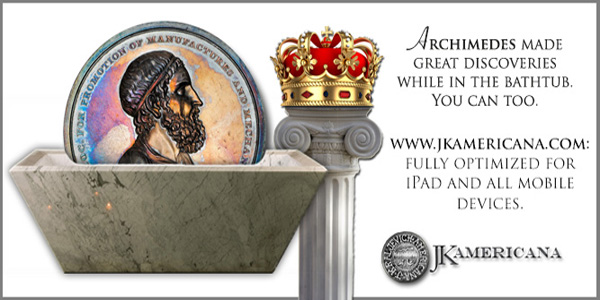
COIN HOARDS AND GOOGLE MAPS SHOW ANTIOCH'S INFLUENCE
 There's a map of an ancient Syrian trade route that shows how one city's political sway extended farther than once thought.
This map isn't a time-worn and mysterious etching on a stone tablet. Turns out it's easily found on a different type of tablet – the kind with apps.
There's a map of an ancient Syrian trade route that shows how one city's political sway extended farther than once thought.
This map isn't a time-worn and mysterious etching on a stone tablet. Turns out it's easily found on a different type of tablet – the kind with apps.
With the swipe of a finger, the University of Cincinnati's Kristina Neumann can zoom along the boundaries of ancient Antioch during the beginning of Roman takeover thanks to the modern cartography of Google Earth software. The simplicity with which she flicks across the Middle Eastern landscape belies the depth of information available at her fingertips and the effort that's gone into her research.
"I trace the process of change by working with historical proxies, in this case coins," says Neumann, a doctoral candidate in the McMicken College of Arts & Sciences Department of Classics. "I created my own database from previously published excavation reports and lists of coin hoards, and imported it to Google Earth. My criteria are so detailed that I can see all the coins for a particular emperor or of a particular material."
She hopes this visual, interactive way of presenting the ancient world inspires other historians to get more creative in today's "there's an app for that" world.
"I'm trying to help historians think outside the box," Neumann says. "There's a huge movement in the digital humanities in general, and this research speaks to that. Using tools such as Google Earth to visualize the ancient world could also have ramifications for how we look at data today."
Neumann will present her research "Using Google Earth to Visualize an Ancient City's Influence: Roman Antioch" at the Archaeological Institute of America and American Philological Association Joint Annual Meeting to be held Jan. 2-5 in Chicago. The meeting attracts more than 3,000 international attendees to share news and ideas among the top archaeological and classical scholars.
In ancient times, much like now, authorities determined which foreign currency was accepted in a community. For Neumann, this made coins an ideal representation of a political relationship among cities. For example, if lots of Antiochene coins were discovered in a neighboring city, it's likely a political agreement existed between the two governments.
Coins were also a data-rich resource for Neumann. In addition to tracking where the coins were found, she cataloged critical information about a coin – such as when it was minted and under whose authority it was made – that has been derived from the images and inscriptions imprinted on it. Other artifacts, like pottery, were less likely to have such identifiers.
Neumann uses Google Earth to convert the vast information in her coin database into a visual representation of Antioch's political borders. She analyzes how the software plots which coins were found where and in what quantity across different historic time periods. This way she can follow the transformation of Antioch's political influence as it was absorbed by the Roman empire.
To read the complete article, see: Money talks when ancient Antioch meets Google Earth (w/ Video) (m.phys.org/news/2014-01-money-ancient-antioch-google-earth.html)
COIN CARD POSTCARD ALBUM CENSUS
Since your recent mention of the coin card postcard album, I searched for mine, and found it. My notes indicate I bought it in May 1989. I made some scans as your readers might be interested in the images.
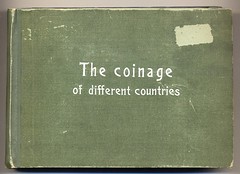 My album has 46 different cards mounted photograph style on 23 pre-corner cut album pages. The front cover states quite simply "The coinage of different countries". Inside the back cover is a small label placed by the original seller of the album, the "Parfumerie und Papierhandlung 'ZUR FORTUNA' ", at "Josefstadterstrasse 58, Wien, VIII", (Austria) at the time Austria-Hungary.
My album has 46 different cards mounted photograph style on 23 pre-corner cut album pages. The front cover states quite simply "The coinage of different countries". Inside the back cover is a small label placed by the original seller of the album, the "Parfumerie und Papierhandlung 'ZUR FORTUNA' ", at "Josefstadterstrasse 58, Wien, VIII", (Austria) at the time Austria-Hungary.
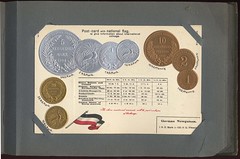 In the early years of the 20th century the entire world was involved in the postcard collecting craze, and a craze it was! I seem to recall reading that, in this initial PC frenzy before World War One, 1905 was the year when the most cards were published, well into the hundreds of millions. The text of this set is in English (on all but the Papal States card in French), even though sold in German speaking Austria, likely for the many foreign tourists making the Grand Tour so popular at the time. The same images would have been available in other major languages like French, German and Spanish.
In the early years of the 20th century the entire world was involved in the postcard collecting craze, and a craze it was! I seem to recall reading that, in this initial PC frenzy before World War One, 1905 was the year when the most cards were published, well into the hundreds of millions. The text of this set is in English (on all but the Papal States card in French), even though sold in German speaking Austria, likely for the many foreign tourists making the Grand Tour so popular at the time. The same images would have been available in other major languages like French, German and Spanish.
The latest date on any country's coin shown is 1904, so it's safe to assume both individual cards and album sets were sold soon thereafter. Each card shows the country's coinage, embossed and colored in the appropriate metallic tint for bronze, silver and gold, along with the nation's flag and in the center, a currency exchange table current in various other countries, this feature very informative for present day researchers seeking the relative values of coinage at the time, the pre-WW I period when most of the world was on a hard currency silver or gold standard.
 This set was published by the German firm "H.S.M.", the acronym for Hermann Sonntag of Munich in the Kingdom of Bavaria. Most, but not all, of the cards have that maker imprint in an upper obverse corner. In the late 80s when I was much more into PC collecting, I would find these at postcard shows in both postally used and unused condition, priced at $5 to $35, depending on scarcity and condition, but the vast majority were in the $10-15 range. The USA card was always the most expensive and difficult to find, a function of greater demand, not because fewer were printed. I focused on small and popular countries like German New Guinea, German East Africa and cards whose countries were numismatically hot at any given time. The handsome Bird of Paradise coinage of GNG is shown in a following scan, along with the divided back reverse on all cards, this one from the Brazilian card where the heavy embossing is very clear.
This set was published by the German firm "H.S.M.", the acronym for Hermann Sonntag of Munich in the Kingdom of Bavaria. Most, but not all, of the cards have that maker imprint in an upper obverse corner. In the late 80s when I was much more into PC collecting, I would find these at postcard shows in both postally used and unused condition, priced at $5 to $35, depending on scarcity and condition, but the vast majority were in the $10-15 range. The USA card was always the most expensive and difficult to find, a function of greater demand, not because fewer were printed. I focused on small and popular countries like German New Guinea, German East Africa and cards whose countries were numismatically hot at any given time. The handsome Bird of Paradise coinage of GNG is shown in a following scan, along with the divided back reverse on all cards, this one from the Brazilian card where the heavy embossing is very clear.
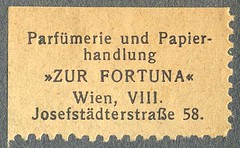 It would be interesting to do a census of existing albums still extant, including the various formats and publishers, along with a list of all the countries eventually published, perhaps a fun project for E-Sylum readers? So, as of now, we have two albums, yours from the mid 1920s and mine from about 1904. How many more are out there?
It would be interesting to do a census of existing albums still extant, including the various formats and publishers, along with a list of all the countries eventually published, perhaps a fun project for E-Sylum readers? So, as of now, we have two albums, yours from the mid 1920s and mine from about 1904. How many more are out there?
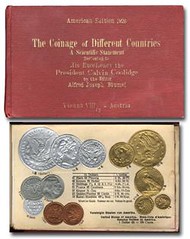 "Off the top of my head I can now
account for 6 of these albums: President Coolidge,
Library of Congress, Johnson, Xenos, Brown (cited in
his bibliography of embossed coin books) and Gladfelter,
ex Jonah Shapiro, ex Imogene Vogel. Who, you might
ask, is Imogene Vogel? A child, probably a tourist on
vacation with her parents, who many years ago received
my copy of this book and scrawled her name in the back.
The book is not identified as a limited edition and does
not look like one. I have my doubts that only 10 copies
were made."
"Off the top of my head I can now
account for 6 of these albums: President Coolidge,
Library of Congress, Johnson, Xenos, Brown (cited in
his bibliography of embossed coin books) and Gladfelter,
ex Jonah Shapiro, ex Imogene Vogel. Who, you might
ask, is Imogene Vogel? A child, probably a tourist on
vacation with her parents, who many years ago received
my copy of this book and scrawled her name in the back.
The book is not identified as a limited edition and does
not look like one. I have my doubts that only 10 copies
were made."
To view the Goldberg lot, see: The Coinage of Different Countries presented to Calvin Coolidge. (www.goldbergcoins.net/catalogarchive/20000624/031596.htm)
To read the earlier E-Sylum articles, see:
POSTCARDS AND NUMISMATICS
(www.coinbooks.org/esylum_v16n51a25.html)
BLUMEL NUMISMATIC POSTCARD ALBUM CENSUS
(www.coinbooks.org/esylum_v08n07a08.html)
HOW ROMAN COWS BECAME COINS
Understanding your Roman treasure coin starts with what may seem like its unlikely connection... to cattle.
One of the Latin words for money is “pecunia,” which originates from the Latin word for “cattle.” In Roman times, cattle provided sustenance, security and an indication of affluence. With cattle you could buy all of life’s necessities and measure your wealth compared to others both within your culture and outside of it.
But trading cattle for goods became increasingly cumbersome in the soon sprawling Roman lands. It just wasn’t practical to drive cattle great distances. In response, crude, shapeless heavy coins were cast in bronze in the fifth century BC. Sometime during the third century BC, Roman coins began to carry images of animals, tridents and shields.
Next came the coinage that was to be the forerunner of all coinage to come. Called “aes grave” (heavy bronze), the coins were still cast, but were circular. Later, around 211 BC, Romans issued the first coins that were uniquely their own.
These are the solidus, denarius, sestarius and quinarius. At last, Roman coins as we think of them were produced - struck coinage that came to be recognized throughout the republic, and later, the empire. These coins bear the image of the emperor, legends (written script) on the obverse and reverse, and deities, personifications, military images, civic images and symbols on the reverse. Struck in bronze, silver and gold, these coins were minted throughout the empire, on and off, as it expanded and contracted throughout the centuries.
To read the complete article, see: Roman currency: How a cow became a coin (www.dailyastorian.com/your_town/cannon_beach/roman-currency-how-a-cow-became-a-coin/article_ab4559a2-7851-11e3-8eb8-001a4bcf887a.html)
PHOTOFUNIA: CREATE A COIN FROM ANY PHOTO
Kavan Ratnatunga writes:
The Free online tool photofunia will instantly create a coin out of any photo.
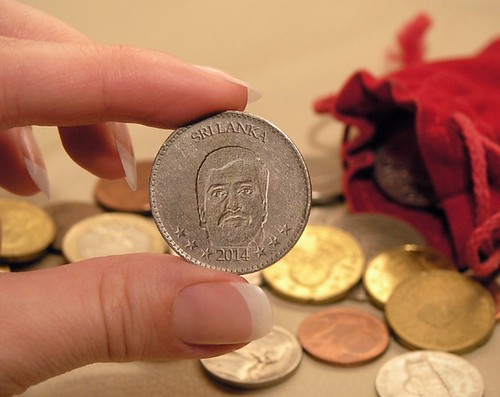
To create your own coin, see: photofunia.com/effects/coin
FEATURED WEB PAGE: PHRYGIAN CAP
This week's Featured Web Page is the Wikipedia entry on the Phrygian cap, a common theme emblematic of Liberty in numismatics.The Phrygian cap is a soft conical cap with the top pulled forward, associated in antiquity with the inhabitants of Phrygia, a region of central Anatolia. In the western provinces of the Roman Empire it came to signify freedom and the pursuit of liberty, perhaps through a confusion with the pileus, the felt cap of manumitted (emancipated) slaves of ancient Rome. Accordingly, the Phrygian cap is sometimes called a liberty cap; in artistic representations it signifies freedom and the pursuit of liberty.
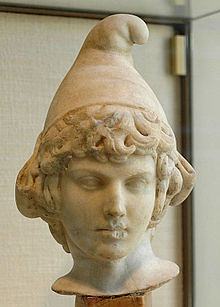
en.wikipedia.org/wiki/Phrygian_cap
